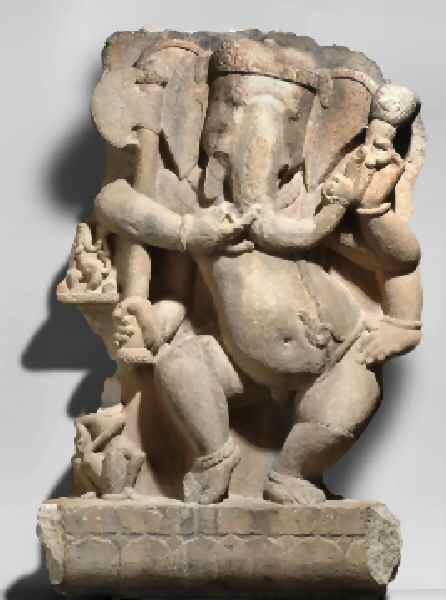|
Ganesh dansant en grès, origine Gwalior, probablement du temple Teli-ka-mandir, hauteur : 127 cm, vers 750, Madhya Pradesh, Inde
Doté d'une ventre dodu et d'une tête d'éléphant, Ganesh est le dieu Hindou le plus largement vénéré. Pour les gens du peuple, il est la source de tout succès. Seigneur des Obstacles, son pouvoir est immense et on doit l'invoquer au commencement de toute entreprise. Il a la capacité de mettre des obstacles sur la route, mais aussi de les ôter. L'image de Ganesh dansant, comme sur cette représentation de grès rougeâtre provenant d'un temple dédié au grand Dieu Shiva, son père, est la représentation qui véhicule le mieux la sagesse joyeuse qu'il incarne, ainsi que la connaissance que les humains sont Un avec l'Absolu. Par l'action de ses quatre bras et de son corps se balançant en une triple courbure, au rythme qu'imprime le joueur de tambourin posté à ses pieds, sa danse se propage dans tout l'Univers. Son bras droit agrippe une hache - son emblème le plus frappant - avec l'aide de son bras inférieur. Sa main gauche supérieure brandit un radis - une friandise pour un éléphant - qui symbolise l'unité (traduction libre). Stella Kramrisch, from Philadelphia Museum of Art: Handbook of the Collections (1995), p. 51. Philadelphia Museum of Art © 2010 Philadelphia Museum of Art. All rights reserved |
Dancing Ganesh in sandstone, from Gwalior (probably Teli-ka-mandir temple), height : 50 inches (127 cm), c. 750, Madhya Pradesh, India
Pot-bellied and elephant-headed, Ganesha is the most widely worshiped Hindu god, for to the ordinary person he is the source of all success. As Lord of Obstacles he is extremely powerful; he must be invoked at the beginning of every undertaking. His is the power to put obstacles in the way--and to remove them. Ganesha dancing, as he is shown in this reddish sandstone sculpture from a temple devoted to the Great God Shiva, his father, is the image that most fully conveys the joyous wisdom that he embodies, the knowledge that humans are one with the Absolute. Four-armed, his body sways in a triple bend to the rhythm beaten out by the spirit drummer below him on the left, and his dance reverberates throughout the universe. His main right arm cradles an ax, his most conspicuous emblem, held by the lower hand. His upper left hand holds a radish--a delicacy for an elephant-which symbolizes unity. Stella Kramrisch, from Philadelphia Museum of Art: Handbook of the Collections (1995), p. 51. Philadelphia Museum of Art © 2010 Philadelphia Museum of Art. All rights reserved |
